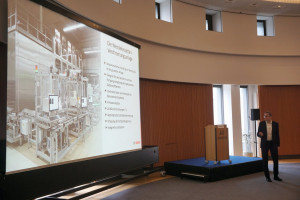Last year's Ulm Dialogue was still characterized by the aftermath of the pandemic. The 44th edition of the renowned conference of the German Society for Electroplating and Surface Technology (DGO) has now finally arrived in the normality of the post-corona era. At the end of May, around 80 participants listened to expert presentations in four thematic blocks on the main topic of "Measuring, controlling, regulating".
As the long-standing conference venue at the Edwin Scharff Haus in Neu-Ulm is being renovated this year, the 80 or so participants met at the Maritim Hotel on the other side of the Danube on May 24 and 25. "The Ulm Talk has arrived in Ulm," joked event director Katja Fiege, who stood in for Prof. Wolfgang Paatsch, who was unable to attend due to illness. Read the interview with her on p. 854. The materials scientist from Fraunhofer IPA in Stuttgart opened the event with the presentation of the Nasser Kanani Award winner. The award was presented for only the second time this year and is endowed with 3000 euros. Prof. Kanani is well known in the industry for his numerous specialist articles and books.
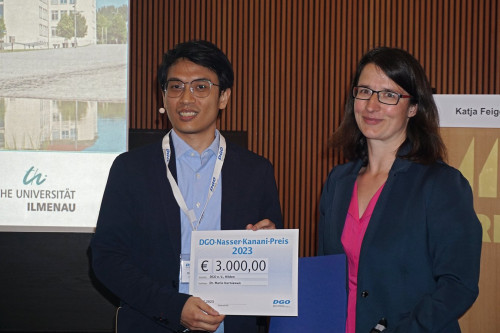 Dr. Mario Kurniawan is riding a wave of success. Following the DGO Young Talent Award, he has now also received the Nasser Kanani Prize
Dr. Mario Kurniawan is riding a wave of success. Following the DGO Young Talent Award, he has now also received the Nasser Kanani Prize
Shortlisted for the prize are works dedicated to the topic of sustainability. This year's winner is postdoctoral researcher at TU Ilmenau Dr. Mario Kurniawan, who was one of last year's winners of the DGO Young Scientist Award. After receiving the award, he gave the introductory lecture.
Preparation and characterization of cuprous oxide for improved photoelectrochemical performance
Dr. Mario Kurniawan, TU Ilmenau
Kurniawan began by listing the advantages of hydrogen as a sustainable green energy carrier. The combination of direct sunlight and semiconductor photoelectrodes in a photoelectrochemical (PEC) cell can produce hydrogen by splitting water molecules into H2 and O2. Cu2Ois a p-type semiconductor that is suitable for the absorption of visible sunlight and also has the appropriate band position for the reduction of water to hydrogen in a PEC cell.
Dr. Mario Kurniawan's work focused on increasing the surface area of Cu2Oto improve the performance of PEC water splitting
The focus of his work was on increasing the surface area of Cu2Oto improve the performance of PEC water splitting. This was achieved by depositing a thin Cu2O filmon a free-standing microporous Cu scaffold, as Kurniawan explained. He gave further details of the process during the lecture. The highly interesting work will be the subject of a specialist article in a forthcoming issue of Galvanotechnik.
Process analysis in chemical metal deposition in the semiconductor industry
Dr. Andreas Walter, Robert Bosch Semiconductor Manufacturing Dresden GmbH, Dresden
In the first presentation of the thematic block on data acquisition and utilization, typical application examples of chemical metal deposition in the semiconductor industry were presented and their process-related challenges were discussed. The general manufacturing process of semiconductor components and its special requirements were also briefly described.
Predictive maintenance - breaking new ground with Kl
 Frank Benner from B+T was predestined to give a presentation at the conference, as Industry 4.0 and digitalization are already largely a reality in his electroplating plant
Frank Benner from B+T was predestined to give a presentation at the conference, as Industry 4.0 and digitalization are already largely a reality in his electroplating plantFrank Benner, B+T Group of Companies, Hüttenberg
Networking production creates new and deeper insights into manufacturing processes, emphasized B+T Managing Director Frank Benner in his presentation. As a result, the complexity of the various influencing factors is recognized and preventive maintenance takes on a new meaning in the field of surface technology. His presentation dealt with the preventive maintenance of chemical processes, the influence of products on processes and, last but not least, how AI can provide support here.
Data tracking and process control in electroplating plants
Dr. Milan Pilaski, Robert Bosch Manufacturing Solutions GmbH, Chemical Coatings, Stuttgart
The presentation by Dr. Pilaski from the Robert Bosch Group gave participants an insight into practical applications. The company requires highly developed coating systems for the custom coating of automotive products, e.g. for the hard chrome plating of solenoid armatures and inner poles for fuel injection components, the custom chrome plating of valve seats for diesel injection pumps, the anodizing of pressure booster housings or the dip coating of lambda sensors. Pilaski described a comprehensive automation and quality assurance concept that, among other things, visualizes coating defects, making it easier to identify the causes and continuously regulate the coating thickness.
Man and machine as team players?! Opportunities and challenges of integrating humans with cyber-physical systems using the example of surface technology
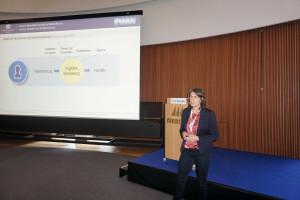 Man and machine as a team - is that possible? Dr. Franziska Boklisch addressed questions like these in her presentation
Man and machine as a team - is that possible? Dr. Franziska Boklisch addressed questions like these in her presentation
Dr. Franziska Bocklisch, Chemnitz University of Technology/Fraunhofer IWU Chemnitz
Dr. Bocklich was the first speaker in the automation and robotics session. The resource-optimized and intelligent industry of the future will be realized through a complex combination of people and cyber-physical systems (CPS), believes the Chemnitz University of Technology scientist. ln research, development and operational practice, people with their expertise and needs should continue to be taken into account. The aim is to create a kind of human-cyber team that can work more efficiently, sustainably and flexibly by combining human and technical strengths in a complementary way. She presented concepts such as human-machine teaming to show how this could also be achieved with regard to surface technology.
Use of high-performance handling systems in high-speed electroplating
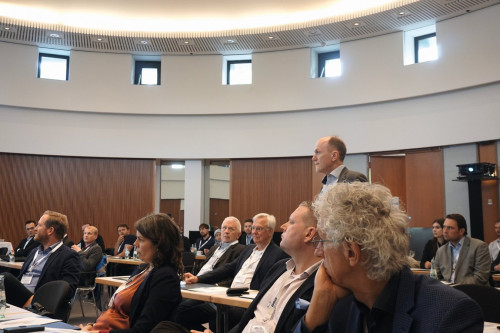 There were always questions in between: here Dr. Eckart Giebler (currently with a rinsing series in the environmental section), who pointed out that the data situation, e.g. for electrolytes, is limited in electroplating technologyTimBergmann, Robert Bosch Manufacturing Solutions GmbH, Chemical Coatings, Stuttgart
There were always questions in between: here Dr. Eckart Giebler (currently with a rinsing series in the environmental section), who pointed out that the data situation, e.g. for electrolytes, is limited in electroplating technologyTimBergmann, Robert Bosch Manufacturing Solutions GmbH, Chemical Coatings, Stuttgart
Like Dr. Pilaski, Bergmann works at Bosch. He presented Bosch's high-speed coating for the automotive supply industry. The aim is to achieve minimum cycle times. The processes are characterized by very high deposition rates compared to conventional coating processes. He presented handling systems for short cycle times, including for dip bath coating and for high-precision process module coating.
Quality-related control of electroplating systems: Traceability of analytical data and system sensors to the coating properties
Dr. Peter Schwanzer, Fraunhofer Institute for Manufacturing Engineering and Automation IPA, Electroplating Technology Department, Stuttgart
The last speaker of the day was Dr. Peter Schwanzer, who focused on the implementation of digitalization in electroplating plants. He presented the experiments, the procedure and the results of the joint research project SmARtPlaS (Smart Augmented Reality Plating Services) (more on this in Galvanotechnik 4/2023 from p. 435). As part of the project, data was produced in a controlled environment in the learning electroplating facility at Fraunhofer IPA via coating tests, which were used to test a procedure for structured processing and analysis of the data, taking into account the electroplating boundary conditions.
lnline/online analysis: New possibilities for recording electrolyte components
Daniel Schlak, Deutsche METROHM Prozessanalytik GmbH Et Co KG, Filderstadt
Daniel Schlak kicked off the second day of the process analysis session. According to Schlak, electroplating process baths have a large number of quality-relevant parameters that must be recorded via quality assurance. Analysis methods such as thermotitration for determining the main components of the electrolytes and Raman spectroscopy for determining organic additives, such as complex images, are used here. Metrohm Process Analytics offers almost all the different analysis methods for online and online monitoring of electroplating process baths, including real-time control, he said, promoting his company and also presenting the IMPACT software, which enables various analysis techniques for real-time process analysis.
Fully automated XRF online system for efficient control and regulation of metal concentrations
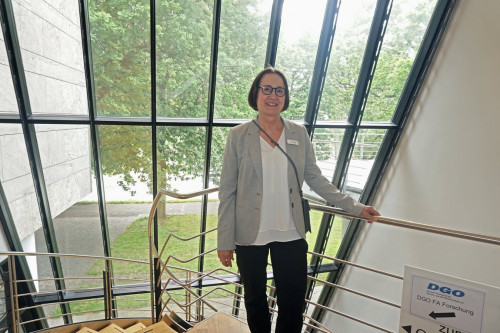 Good soul of the event: Sabine Groß from DGO took care of the organization of the event and was always available to answer questionsMonikaHofmann-Rinker, B+T K-Alpha GmbH, Hüttenberg
Good soul of the event: Sabine Groß from DGO took care of the organization of the event and was always available to answer questionsMonikaHofmann-Rinker, B+T K-Alpha GmbH, Hüttenberg
X-ray fluorescence analysis (XRF) for determining the concentration of metals in liquids is well suited for online analysis and automation of the measurement process. Thanks to networking, measurement data, status messages and alarms from the analysis system are available to B+T in real time and from any location, enabling efficient concentration control. In the KinGaTec research project, B+T is currently working with research partners to determine how automation and artificial intelligence (AI) can be used to predict and specifically utilize the influence of process parameters, such as the metal concentration in the alkaline zinc-nickel bath. The aim is to make optimum use of the available resources and to be able to use "smart parameters" to provide reliable information about the quality, layer thickness and surface of the product in advance of the coating process.
Product-related mechanical properties of electroplated coatings - adjustment and control
Dr. Dirk Rohde, Atotech Deutschland GmbH, Berlin
Using examples, product-related requirements for the mechanical properties of electroplated metallic coatings and the necessary process control were discussed. Electroplated copper layers are exposed to high mechanical stress in so-called advanced packaging applications. Another topic of the presentation was the hydrogen embrittlement of components when coated with corrosion protection layers.
New sensor technology for chemical baths
Dr. Daniel Wett, Institute for Corrosion Protection GmbH, Dresden; Felix Bauer, TU Bergakademie Freiberg, Institute for Electronic and Sensor Materials, Freiberg
The presentation was dedicated to the development of a new type of triple sensor chip that is able to generate measured values for intelligent regulation and control in aqueous chemical baths (recording of temperature, conductivity and pH value measurement on a chip) in real time. The longer-term vision is to use the cost-effective and mechanically robust sensor in the in-situ monitoring of process baths in real time
Quality assurance in plastic electroplating using the example of chrome-plated components
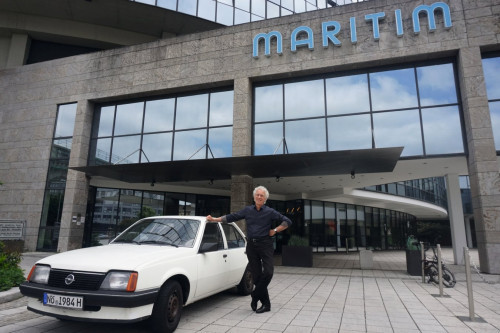 Joachim Ramisch with his Opel Ascona, which he painstakingly restored in his electroplating shop and elsewhereDr. Kirsten Pleßow, Saxonia Galvanik GmbH, Halsbrücke
Joachim Ramisch with his Opel Ascona, which he painstakingly restored in his electroplating shop and elsewhereDr. Kirsten Pleßow, Saxonia Galvanik GmbH, Halsbrücke
Dr. Pleßow's presentation marked the start of the last topic block, quality assurance. She gave an insight into practice. Saxonia Galvanik is a supplier of electroplated coatings on metal and plastic. In the high-volume segment, various products are coated over their entire surface or selectively, mainly for the automotive industry. Quality assurance measures are part of the entire production process, from incoming goods inspections to inspections during production and outgoing goods inspections. At Saxonia, both automated surface inspections and visual inspections by humans are used.
Six Sigma in electroplating research and development
Katrio Söntgerath, MacDermid Enthone GmbH, Langenfeld
Modern process management now encompasses various activities, such as process analysis, the creation of process indicators and benchmarking, process monitoring and process optimization. Various approaches and methods for process optimization have become established in recent years. These include the company suggestion scheme. Troubleshooting, CIP or Kaizen, lean production/lean management and Six Sigma. Using the Six Sigma methodology in the field of electroplating can, for example, improve yield, reduce the error rate, increase process capability and optimize throughput times. The methodology offers methods and analysis procedures for this purpose.
Machine capability and process capability - possibilities of statistical optimization and practical examples from the industry
Johannes Lauterbach, Schaeffler AG, Herzogenaurach
In the Surface Technology department of the automotive and industrial supplier Schaeffler AG, the company's own coating processes are subject to permanent analysis and optimization. Statistical methods, such as the calculation of key figures for machine and process capability, are used for this purpose.
However, in addition to fascination, there was also a certain unease about AI
Lauterbach's presentation marked the end of a lively conference, which was characterized by many questions regarding measurement technology and digitalization. After all, despite all the euphoria about the possibilities presented, many methods of measurement technology have not yet arrived in electroplating. The participants agreed that the data available on electrolytes, for example, still leaves a lot to be desired. "We are still at the beginning," confirmed Prof. Thomas Lampke from Chemnitz University of Technology. Presentations relating to artificial intelligence, such as those by Dr. Franziska Bocklisch and Frank Benner, were also thought-provoking. Dr. Bocklisch's presentation was sometimes philosophical in nature, as it already envisaged a future collaboration between humans and machines and underpinned this with findings from cognitive psychology, for example. This stimulated the imagination of the participants. However, in addition to fascination, there was also a certain unease about AI, which was certainly also due to the controversial discussion about the introduction of artificial intelligence such as ChatGPT in public.
One person who is more marginally interested in the topic of AI, but who should not be missing from any DGO event, is Joachim Ramisch. He presented one of his life projects to Galvanotechnik on the fringes of the event: The Ascona project. Ramisch has been restoring the old Opel from the 1980s for a long time. Many of the parts were electroplated in the company's own electroplating shop. At the end of May in Ulm, the time had come for a photo - a worthy conclusion to a successful and insightful event.
Photos: Robert Piterek


